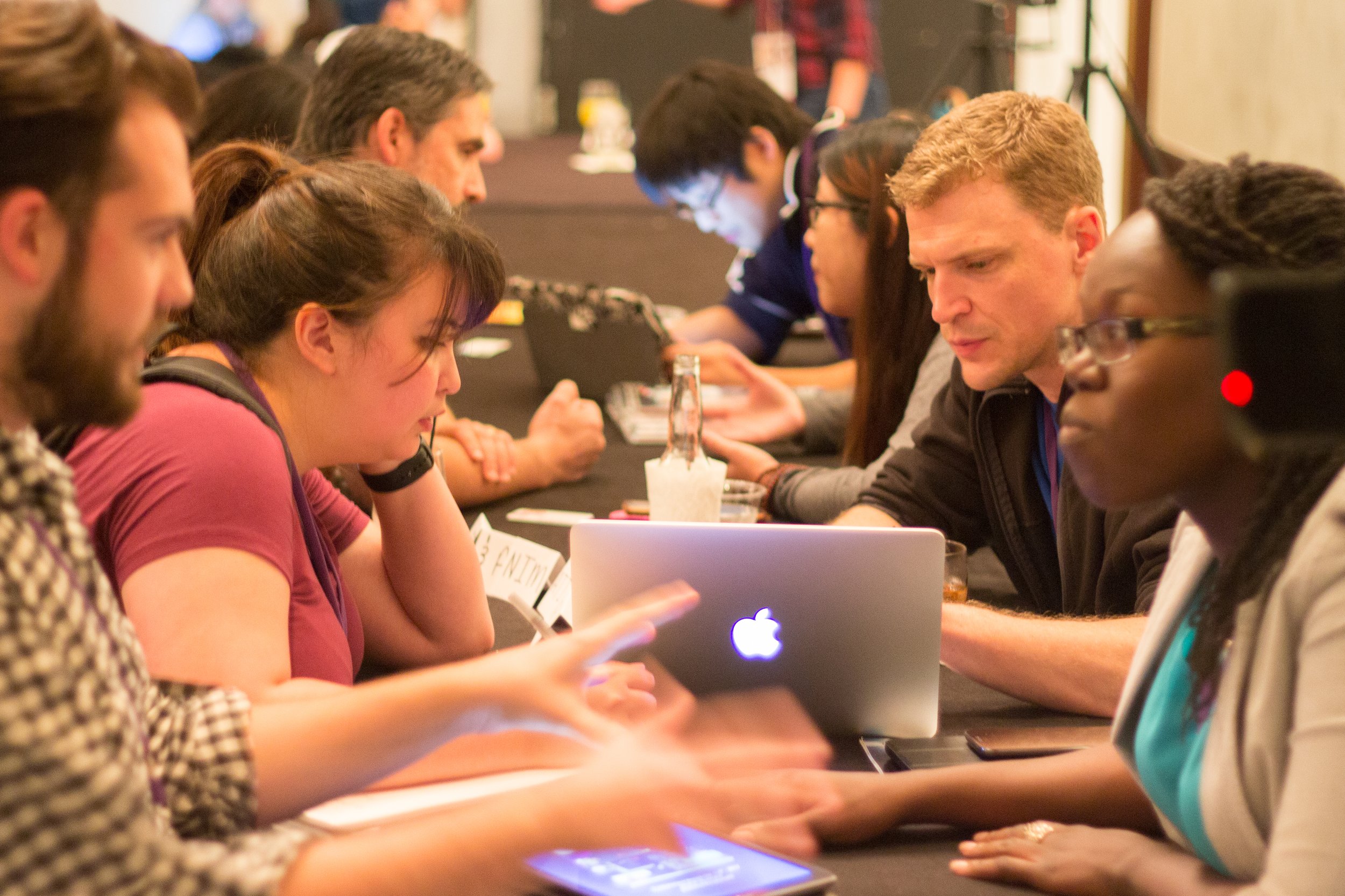News
Game Studio Workplace Design for COVID-19
July 03, 2020
(c)Meldrena Chapin, PhD, WELL
Design Research Consultancy
For the Georgia Game Developers Association
Overall
Studies of GGDA members strongly indicate that their productivity has either stayed the same or improved under work-from-home orders. We recommend that:
Studios continue such work-from-home policies unless it is necessary to reopen, as there is no guaranteed way to prevent the spread of COVID-19 in an office.
If you reopen, only require essential workers come into the studio.
Others should continue working from home.
When you reopen, we suggest the following to minimize risk:
Building Entry, Lobbies and Elevators
Provide only one entrance to the building to allow for screening of everyone entering the building.
Set up a protocol for screening and preparing everyone who enters the building.
Provide temperature checks and other screening measures as desired.
Provide 60% alcohol-based hand sanitizer, wipes, tissues, and Personal Protective Equipment (PPE) such as masks, googles, face shields and gloves.
Provide walk-off mats, disinfectant sprays to clean shoes, and/or place to leave shoes in order to limit containments coming into the building. Consider offering guests shoe covers.
Deliveries should be restricted to a dedicated entry where boxes and their contents can be screened and disinfected before being brought into the work space.
If possible provide a separate waiting area for guests such as game testers and clients to minimize guest exposure to common employee work areas.
Place touchless trashcans at all exits so that PPE such as masks, googles, face shields and gloves may be discarded safely when leaving the building.
Encourage stair use, rather than elevators. Limit the number of people in elevators or consider a single-use elevator policy. Clean elevators daily according to CDC cleaning guidelines. Place protective cleanable cover over elevator buttons.
Stagger work times so that not all employees are arriving or exiting at the same time.
Personal Protective Equipment
Provide masks, face shields or goggles, and gloves for all employees and guests.
Develop a protocol for using PPE
Provide training on the proper use of masks (covering nose and mouth), application and removal of gloves, and cleaning of face shields and goggles.
Offer routine checks and friendly reminders regarding the proper use of PPE.
Work Areas
Furniture layouts and circulation paths may need to be reconfigured to allow physical distancing between coworkers.
Space seating, desks, and or work stations at least 6 feet apart when feasible.
If work stations cannot be moved, stagger work stations by using only every other one.
Provide personal dedicated equipment (head phones, games consoles, keyboards, mice, etc) to all employees.
Install physical barriers, such as sneeze guards and/or solid partitions between workstations where individuals cannot remain at least 6’-0” apart.
Implement floor markings (i.e., paint/tape) to visualize recommended spacing 6’-0” among coworkers and to designate personal work zones.
Designate one-way direction for foot traffic throughout the work place.
In meeting spaces, leave empty chairs or remove every other chair in conference rooms
Decrease density. Continue to work remotely or stagger the number people in the office, one third in the office, two thirds working from home.
Game Testing Centers
Provide personal dedicated equipment (head phones, controllers, games consoles, keyboards, mice, etc) to frequent testers.
Provide individual equipment (head phones, games consoles, keyboards, mice, etc) to other testers.
Have a protocol for cleaning gaming equipment between users.
Provide wipes for testers to clean personal equipment.
Space testing consoles 6’-0” apart, or use every other station.
Place plastic guards or solid partitions between testers seated at consoles side by side within 6’-0”.
Place plastic guards or solid partitions between testers seated face-to-face at gaming stations within 6’-0”.
NOTE: Make sure that guards and solid partitions do not hinder ADA accessibility or fire protection features such as sprinklers or exit paths.
Livestreaming and Recording Studios
Provide personal dedicated equipment (head phones, microphones, keyboards, controllers, etc) to frequent livestreamers.
Provide individual equipment (head phones, microphones, games consoles, etc) to other livestreamers.
Have a protocol for cleaning equipment between users.
Provide supplies for livestreamers to clean personal equipment.
Clean microphones before and after all sessions. Request that streamers bring their own personal pop filters and sanitize them themselves. Isopropyl alcohol is recommended for cleaning.
Place plastic guards or solid partitions between livestreamers seated side by side within 6’-0”.
Place plastic guards or solid partitions between livestreamers seated face-to-face within 6’-0”.
NOTE: Make sure that guards and solid partitions do not hinder ADA accessibility or fire protection features such as sprinklers or exit paths.
Handwashing and Rest Rooms
Post reminders about handwashing for at least 20 seconds with soap.
Maintain 6’-0” between sink users
Use hands-free paper towel dispensers, rather than air dryers which can blow contaminants.
Offer touch-less soap dispensers, sink faucets, toilets, etc.
If possible, prop open doors to avoid touching door handles, but watch for line of site into rest rooms.
Provide touchless trashcans near doorways
Install hand sanitizers outside restrooms for cleaning hands on the way in and out of the rest room.
Install motion sensor or touchless light controls.
Proper and frequent cleaning and disinfection is needed for high-touch surfaces, such as doorknobs, faucets, sinks, toilets, stall door openers and paper towel dispensers. Clean and disinfect restrooms a minimum of once daily.
Breakrooms
Provide hands-free water and beverage dispensers.
Provide single serving snacks rather than larger containers.
Post signs reminding coworkers to wash hands.
Provide hands-free soap dispensers, touch-free paper towel dispensers, tissues, and hands-free trashcans.
Provide cleaning equipment and antibacterial cleansers for dining tables and counters.
Clearly identify protocols for dirty cups, plates, and silverware.
Clean eating surfaces, food prep surfaces, cups, plates, and cutlery daily according to CDC guidelines.
Provide cleanable, transparent films or cleaning products for arcade games and other entertainment equipment.
Limit the numbers of employees in breakrooms in order to maintain 6’-0” social distancing requirements.
Ensure that outside smoking areas allow for 6’-0” social distancing requirements.
General Cleaning Protocols
Increase cleaning, sanitization and restocking.
Proper and frequent cleaning and disinfection is critical for all high-touch surfaces, such as elevator buttons, doorknobs, handrails, counters, desks, keypads, computer screens, etc.
Provide cleanable, transparent films over surfaces such as elevator buttons, door key pads, .
Strengthen cleaning protocols: Adjust cleaning protocols to meet the demands of the current situation. Increase cleaning frequency, replenish cleaning supplies ahead of time, and ensure that the workplace stays stocked with appropriate cleaners, cleaning gloves, hand soap, hand sanitizer, paper towels, tissues and personal protective equipment.
Consider periodic operational break(s) during business hours for employees to undertake cleaning of workstations and common rooms.
Consider periodic third-party deep cleaning / sterilization services, especially in locations where known infected persons were present
Air Quality
Good indoor air quality is necessary for the health of occupants.
Increase the amount of outdoor air circulating in the building by increasing air exchange rate (minimum four air exchanges per hour) and fan capacities or opening windows.
Consider a fixed maximum number of occupants per HVAC zone
Change HVAC air filters prior to occupancy
Filter indoor air by using HEPA filters or MERV15 filters. Since COVID-19 is an extremely small pathogen investigate using an upper-air UV-C fixture, which destroys microbes and reduces contaminants in air circulation.
Consider the use of portable room air cleaners that use HEPA filters.
Add plants, especially in high traffic areas such as building lobbies. Plants organically filter air and breathe oxygen into indoor spaces.
In larger buildings check condensate and bacterial growth along windows and in cooling systems and water towers.
Humidity
Scientific evidence suggests that viruses do not live in high humidity.
Set HVAC systems to maintain relative humidity between 40% – 60%.
If necessary, use portable humidification systems.
NOTE: be cautious maintaining extended relative humidity at 55% or above - computer (and other) electronic components can be damaged by high humidity, water condensation and resulting corrosion.
Water
For buildings which have been closed for 30 days or more, perform an operational flush of all water systems by running water from all taps for three to five minutes and flush all toilets prior to occupancy.
If providing water fountains, clean mouthpieces, protective guards, and basins daily according to CDC guidelines. Clean outlet screens and aerators to remove debris and sediment. Replace water filters.
Workplace Policies
Discontinue nonessential travel in favor of virtual meetings when possible.
Develop an emergency communications plan.
Identify necessary revisions to human resources policies.
Provide up-to-date, accurate education and training on COVID-19.
Identify occupants in higher health risk categories.
Allow paid time off for sick employees to reduce incentive to work while sick.
Establish a protocol for anyone not feeling well.
Establish procedures for immediately isolating those who have signs or symptoms of COVID-19.
Develop organizational policies to guide what happens if and when a person at the workplace is found to be COVID-19 positive, including testing and quarenting those working closely with a Ciovd-positive co-worker.
Establish procedures for returning to work after COVID-19 positive infections.
Establish an official guide of an approved protocol to manage employee and customer safety.
Institute social distancing strategies.
Create and institute virtual communications and telework policies.
Implement occupancy-reduction policies, such as staggering worktimes, employing work shifts, or work fromm home opportunities.
Develop policies to reduce risk related to high-touch practices.
Use intermittent reinforcement to reward employees and guests for proper use of PPE and other new policies. Gift cards, company swag, game keys and GGDA memberships are all great for this purpose.
Resources
American Institute of Architects. (2020, May 6). Re-occupancy Assessment Tool v1.0. Retrieved from https://www.aia.org/resources/6292441-re-occupancy-assessment-tool
Bahadursingh, N. (2020). 8 Ways COVID-19 Will Change Architecture. Retrieved from: https://architizer.com/blog/inspiration/industry/covid19-city-design/
Caufield, J. (2020, June 14). Infection Control in Office Buildings: Preparing for re-occupancy amid Coronavirus. Building Design + Construction Network. Retrieved from: https://www.bdcnetwork.com/infection-control-office-buildings-preparing-re-occupancy-amid-coronavirus
Caufield, J. (2020, June 14). A New Report on How Campus Buildings can Reopen Safely. Building Design + Construction Network. Retrieved from: https://www.bdcnetwork.com/new-report-how-campus-buildings-can-reopen-safely
Center for Active Design. (2020, March 24). 5 Ways to Optimize Buildings for COVID-19 Prevention. Retrieved from https://assets.ctfassets.net/fuo6knzstk5a/3lsqTMys2rHZrMijLHrDcT/d65e3a2f62a26a1cdc69e0f372ea1bf0/CfAD-Fitwel-COVOID19-5Strategies.pdf
Goby and fitwel. (2020, May 21). Prioritizing Health and Wellness Initiatives in Response to COVID-19. Retrieved from https://go.gobyinc.com/hubfs/Webinars/Prioritizing%20health%20and%20wellness%20initiatives%20in%20response%20to%20COVID-19%20slides.pdf
Gray, W. A. (2020, May 27). Why Building Design Matters in Response to Coronavirus: Your office building as a risk management solution. Retrieved from https://medium.com/@whitneygray/why-building-design-matters-in-response-to-coronavirus-e534c95bc021
Heinly, J. K. (2020, March 15). Designing Office Building Lobbies to Respond to the Coronavirus. Gensler Dialogue. Retrieved from https://www.bdcnetwork.com/blog/designing-office-building-lobbies-respond-coronavirus
Kellett, E.; Grant, A.; and Cowman, K. (2020). Returning to Campus during the Covid-19 Pandemic. Leo A. Daly. Retrieved from https://issuu.com/leoadaly7/docs/returning_to_campus_during_the_covid-19_pandemic_s
National Fire Prevention Association [NFPA]. (2020, June 9.) NFPA develops business reopening checklist for fire and life safety measures. Building Design + Construction. Retrieved from https://www.bdcnetwork.com/nfpa-develops-business-reopening-checklist-fire-and-life-safety-measures
Perkins, B. and Siefering, M. (2020, May 11). Experts offer a 13-point plan to reduce coronavirus deaths in nursing homes. Building Design + Construction Network. Retrieved from: https://www.bdcnetwork.com/covid-19nursinghomedeaths
Recording Academy. (2020, May 28). Technical Guidelines. Retrieved from https://www.grammy.com/technical-guidelines
Zetlin & De Chiara LLP. (2020, May 5). The Post Pandemic Office: Perspectives on the New Normal. Retrieved from https://www.zdlaw.com/assets/htmldocuments/The%20Post%20Pandemic%20Office-Perspectives%20on%20the%20New%20Normal%20Event%20Summary.pdf














